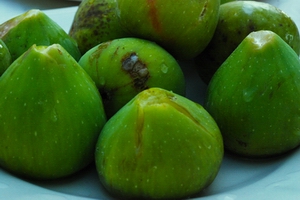 e in our lives, many of us opted for tasty fig newton cookies as a healthier cookie than all the others. Then came the Fig Newmans sold in health food stores. Yippee, completely healthy treats!
e in our lives, many of us opted for tasty fig newton cookies as a healthier cookie than all the others. Then came the Fig Newmans sold in health food stores. Yippee, completely healthy treats!Almost but not quite. They both contain corn syrup and processed flours and sugar. Although many sources claim corn syrup is not as bad as more highly processed high fructose corn syrup (HFCS), there are also claims that the label corn syrup may be currently used to disguise HFCS.
Fig Newmans are better choices. But even better than both choices are figs only, fresh or dried, unless you're willing and able to make your own fig jam and totally organic, processed sugar free cookie wrap for homemade fig newtons.
Figs have been around for centuries, probably originating in Egypt around 9200 BC. Adding the 2,000 plus AD years after the BC point places figs into the Paleo diet philosophy of eating only foods that existed before the age of agriculture.
Dried figs or jam mixtures are used commercially because fresh figs don't hold up well, although they are recommended if you use them quickly. Still popular in the Mediterranean, eating figs has been mostly abandoned in North America, except for those cookie versions of course.
Here is some nutritional information about figs that will surprise you and maybe motivate you to include figs in your diet.
Seven reasons for including figs in your diet
(1) This might be your first surprise: Figs help build stronger bones. They contain the essential bone building trio of magnesium, calcium, and vitamin K2.
Without magnesium, calcium is inert. And without K2, calcium strays away from bone matter and into the blood, possibly calcifying blood vessel inner linings.
(2) Figs are good for heart health. In addition to minimizing calcium deposits in your blood vessels, the magnesium and potassium in figs are essential for maintaining heart health and keeping blood pressure in line.
(3) Figs are high in both soluble and insoluble fiber. Soluble fiber helps slow digestion and make you feel fuller. It also helps stabilize and lower blood sugar levels. It's good for soothing irritable bowel syndrome (IBS).
Insoluble fiber provides the bulk needed to help cleanse the large intestine and eliminate waste easily, reducing constipation incidences. Both types of fiber combine as useful tools for weight management.
(4) Figs help lower serum triglyceride levels. Triglyceride levels are considered more relevant markers for predicting heart health issues and obesity than cholesterol readings.
(5) Dried figs are at the top of the dried fruit list for phenol antioxidant levels. Fruit antioxidants have demonstrated higher eye health benefits than vegetable antioxidants, including carrots, even offering protection against age related macular degeneration (ARMD), the leading cause of blindness.
(6) Figs are alkaline producing, helping the body achieve and maintain that optimum 7.0-7.4 pH reading to lead a disease-free healthy life.
(7) Figs are very high in iron, the mineral that helps create red blood cells and prevent anemia. Pregnant women are encouraged to keep their red blood cell levels high. So shove the pickles and chocolates aside and snack on dried figs if you're expecting.
A cautionary conclusion
Dried figs are higher in natural sugar content than fresh figs. Fresh figs have lower sugar contents, but they're not as commonly retailed as dried figs, and they don't keep nearly as long.
But if you're concerned about the sugar content and you're pre-diabetic or worse, consider fig leaves, not for concealing private parts, but for eating. Fig leaves have repeatedly demonstrated anti-diabetic properties.
A study that offered fig leaves for breakfast to diabetics showed they required less insulin injections than usual throughout the rest of the day.





